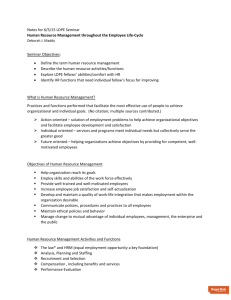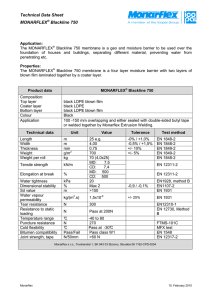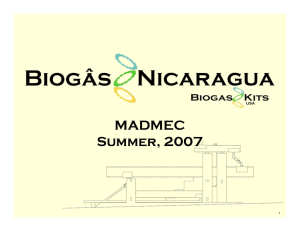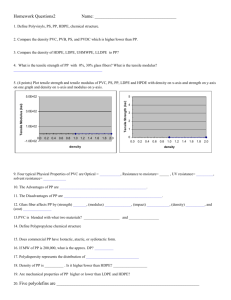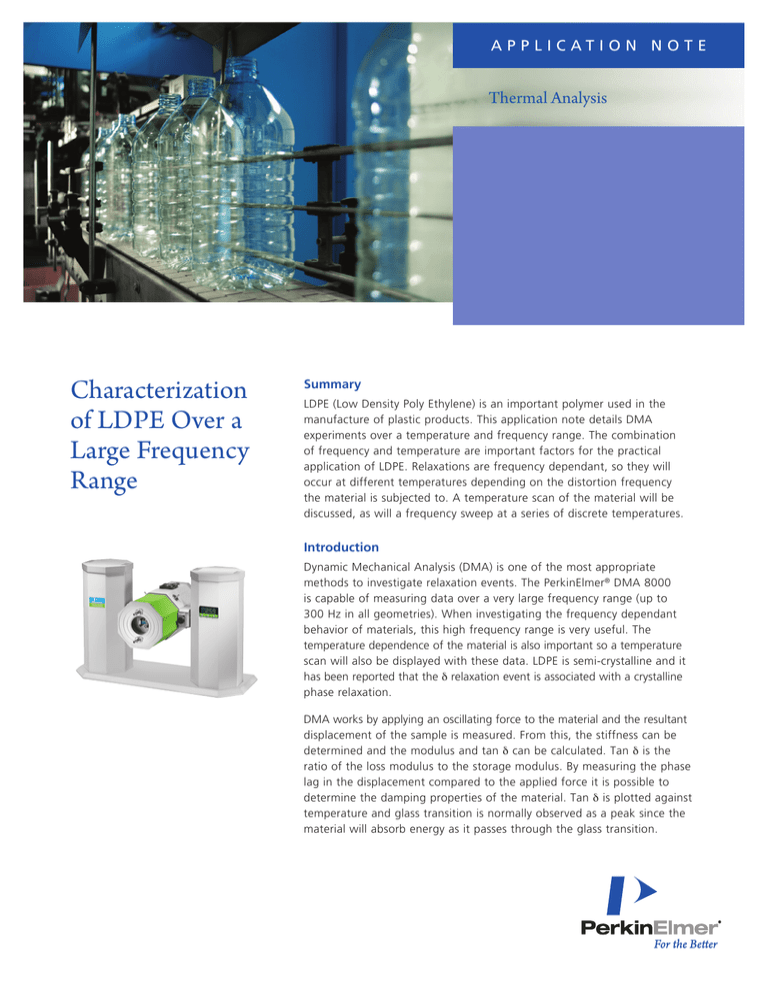
a p p l i c at i o n N o t e
Thermal Analysis
Characterization
of LDPE Over a
Large Frequency
Range
Summary
LDPE (Low Density Poly Ethylene) is an important polymer used in the
manufacture of plastic products. This application note details DMA
experiments over a temperature and frequency range. The combination
of frequency and temperature are important factors for the practical
application of LDPE. Relaxations are frequency dependant, so they will
occur at different temperatures depending on the distortion frequency
the material is subjected to. A temperature scan of the material will be
discussed, as will a frequency sweep at a series of discrete temperatures.
Introduction
Dynamic Mechanical Analysis (DMA) is one of the most appropriate
methods to investigate relaxation events. The PerkinElmer® DMA 8000
is capable of measuring data over a very large frequency range (up to
300 Hz in all geometries). When investigating the frequency dependant
behavior of materials, this high frequency range is very useful. The
temperature dependence of the material is also important so a temperature
scan will also be displayed with these data. LDPE is semi-crystalline and it
has been reported that the δ relaxation event is associated with a crystalline
phase relaxation.
DMA works by applying an oscillating force to the material and the resultant
displacement of the sample is measured. From this, the stiffness can be
determined and the modulus and tan δ can be calculated. Tan δ is the
ratio of the loss modulus to the storage modulus. By measuring the phase
lag in the displacement compared to the applied force it is possible to
determine the damping properties of the material. Tan δ is plotted against
temperature and glass transition is normally observed as a peak since the
material will absorb energy as it passes through the glass transition.
Experimental
1. Temperature scan of LDPE.
The LDPE sample was mounted in the Single Cantilever
Bending clamps and run from ambient to melting temperature.
Data was collected at three frequencies.
2. Frequency scan of LDPE at five temperatures.
The LDPE sample was mounted in the Single Cantilever
Bending clamps. The temperature was stepped from 0 °C to
100 °C in 25 °C increments. A series of discrete frequencies
were investigated at each temperature.
3. Isothermal frequency scan of LDPE (30 discrete
frequencies).
The LDPE sample was mounted in the Single Cantilever
Bending clamps and run at ambient temperature at multiple
frequencies.
Equipment Experimental Conditions
DMA 8000
1L Dewar Sample:
LDPE
Geometry:
Single Cantilever Bending
Dimensions: 5.0 (l) x 3.6 (w) x 5.0 (t) mm
Temperature: 0 °C to 100 °C in step isothermal mode
Frequency:
behavior is not frequency dependent, this event has to be a
relaxation quite separate from melting. As mentioned in the
introduction, it has been reported that there is an δ relaxation
associated with the crystalline phase in this temperature range.
The data here confirms this.
Figure 2 shows a more comprehensive frequency sweep of
LDPE run at 22.5 °C. There is a general trend of decreasing
tan δ as frequency is increased and the modulus remains
approximately constant.
Figure 3 shows frequency data at a range of temperatures.
Fairly linear relationships are observed for tan δ and modulus
which is to be expected if no relaxation event is present. At
100 °C this relationship changes and tan δ increases with
frequency. This result further supports the theory of a
relaxation event at around 100 °C.
Note, the distortion in the data at 250 Hz corresponds to
the resonance frequency of the sample. The instrument was
able to continue with the frequency sweep through resonance
to collect the full range of data.
0.1 to 300 Hz
Figure 2. Frequency data at various temperatures.
Figure 1. Temperature data at three frequencies.
Results and conclusion
Figure 1 shows the temperature scan data at three frequencies
for LDPE. The large increase in tan d and decrease in modulus
at around 100 °C is the onset of melting. Note, just prior to
the melting event, there is a frequency dependence. As melting
Figure 3. LDPE run at 22.5 ˚C.
PerkinElmer, Inc.
940 Winter Street
Waltham, MA 02451 USA
P: (800) 762-4000 or
(+1) 203-925-4602
www.perkinelmer.com
For a complete listing of our global offices, visit www.perkinelmer.com/ContactUs
Copyright ©2007-2011, PerkinElmer, Inc. All rights reserved. PerkinElmer® is a registered trademark of PerkinElmer, Inc. All other trademarks are the property of their respective owners.
007771B_13

